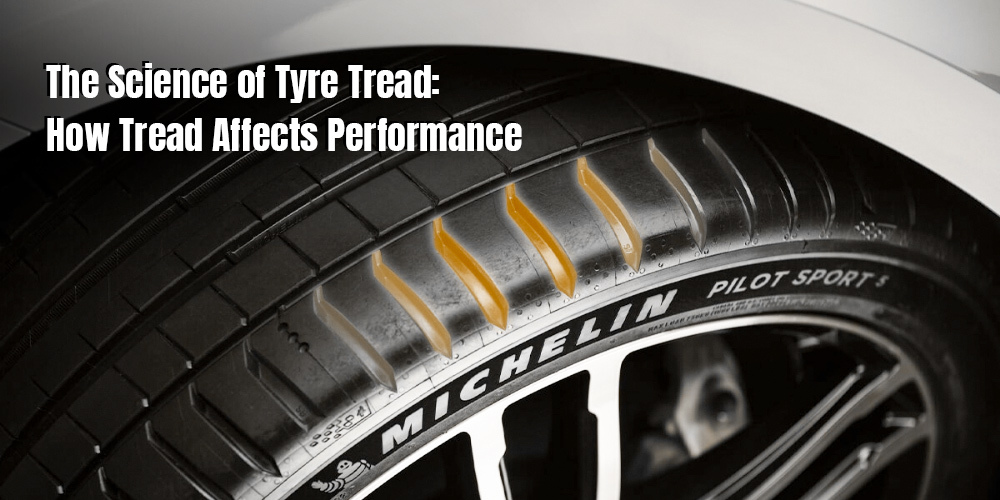
The Science of Tyre Tread: How Tread Affects Performance
Tyre tread is the rubber portion of the tyre that comes into contact with the road. It is responsible for providing traction, handling, and stability on different road surfaces and in various weather conditions. Here are some important things to know about tyre tread:
Tread depth: The depth of the tyre tread is a crucial factor in determining the tyre's ability to grip the road. In general, tyres with deeper tread provide better traction, especially in wet or slippery conditions. The minimum legal tread depth in many countries is 1.6 mm, but it's recommended to replace tyres when the tread depth reaches 2-3 mm.
Tread patterns: Tread patterns can vary depending on the type of tyre and its intended use. For example, tyres for off-road or winter driving may have larger tread blocks or deeper grooves to provide better traction on uneven or slippery surfaces.
Wear indicators: Most modern tyres have wear indicators, which are small raised bars located in the tyre tread. These bars become visible when the tread depth reaches the minimum legal limit or the manufacturer's recommended replacement point.
Rotation: Regularly rotating your tyres can help ensure even wear across the tread surface, which can extend their lifespan and improve their performance. Consult your owner's manual for recommended rotation patterns and intervals.
Balancing: Unbalanced tyres can cause uneven wear and vibration, which can lead to other problems. Balancing your tyres involves adding weights to the wheel to balance out any uneven distribution.
Alignment: Proper wheel alignment ensures that your tyres are properly angled and pointed in the right direction. Misaligned tyres can cause uneven wear, poor handling, and reduced fuel efficiency.
Tyre tread is a critical factor in determining the performance, safety, and longevity of your tyres. Regular maintenance, including checking the tread depth, rotating, balancing, and aligning your tyres, can help ensure they perform their best and last as long as possible.
While tyre tread is a crucial component, it also serves various functions to increase the performance of your vehicle. Here are some ways that tyre tread affects tyre performance:
Traction: Tyre tread provides the grip necessary for a vehicle to accelerate, brake, and turn safely. Tread patterns with deep grooves and channels help evacuate water, snow, and debris, improving traction and preventing hydroplaning.
Wear: As a tyre wears, the tread depth decreases, which affects its ability to grip the road. A tyre with worn tread has less surface area in contact with the road, reducing traction and increasing the risk of accidents.
Rolling resistance: Rolling resistance is the force required to move a tyre along the road. Tread design and depth can affect rolling resistance, which can impact fuel efficiency. Tread patterns with shallower grooves and a smoother surface can reduce rolling resistance, improving fuel efficiency.
Noise: The tread pattern and depth can affect the noise level of a tyre. Tyres with larger tread blocks and deeper grooves tend to be noisier than tyres with shallower grooves and smaller tread blocks.
Heat dissipation: Tyre tread helps dissipate heat generated by friction between the tyre and the road. This is especially important for high-performance tyres that can generate a lot of heat during aggressive driving.
Load-carrying capacity: Tread design and depth can affect a tyre's load-carrying capacity. Tyres with deeper tread and stronger construction can support heavier loads.
Overall, tyre tread is a crucial factor in determining tyre performance, safety, and longevity. Proper tyre maintenance, including regular inspections, rotation, and replacement, can help ensure that your tyres maintain their tread depth and continue to provide optimal performance on the road.
Here are some signs of good tyre tread:
Tread depth: The depth of the tyre tread is a crucial factor in determining the tyre's ability to grip the road. Good tyre tread will have a depth that is above the legal minimum and the manufacturer's recommended replacement point. You can use a tread depth gauge or the penny test to check the tread depth of your tyres.
Even wear: Good tyre tread will have even wear across the surface of the tyre. Uneven wear can be a sign of alignment or suspension problems, and it can affect the tyre's performance and lifespan.
No visible damage: Good tyre tread will be free of any visible damage, such as cuts, punctures, bulges, or cracks. Any of these issues can compromise the structural integrity of the tyre and increase the risk of a blowout.
Tread pattern intact: The tread pattern of good tyre tread will be intact and clearly visible. The grooves and channels should not be worn down, flattened, or filled with debris. The tread pattern is important for providing grip and channeling water away from the tyre.
Tread wear indicators: Many tyres have wear indicators built into the tread, which become visible as the tread wears down. Good tyre tread will not have any visible wear indicators, as this means the tyre has not reached the minimum legal tread depth or the manufacturer's recommended replacement point.
Good tyre tread should be deep, even, intact, and free of any visible damage or wear indicators. Regular tyre maintenance and inspections can help ensure that your tyres maintain good tread and continue to provide optimal performance and safety on the road.
EverTyres is your one-stop shop for reasonable, high-quality tyres, carrying a large selection at low costs. EverTyres is renowned for providing its customers with high-quality tyres at wholesale costs. The experts have done everything possible to provide the most promising goods and services over the years.


